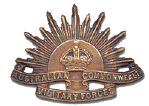 |
| Category: Equipment |

|
|
|
|
|
|
Barracks for the Troops. Page
2 |
 |
Townsville,
Qld. 1945-03-30. Members
at the Regimental Aid Post, 66 AWAS barrack. Identified personnel are: -Sgt
E M Marlay, Regimental Aid Post orderly, (1); Cpl G. Peterson, (2);
Lieutenant J. Elliot, Officer Commanding 66 AWAS barrack, (3).
|
 |
Townville,
Qld. 1945-03-30. Corporal
P. Clegg, (1), walking through the 66 AWAS barrack area.
|
 |
Darwin, NT. 1945-04-06.
Sydney William huts at 69 AWAS barrack.
Each hut accommodates 16 girls in the sweltering heat.
|
 |
Adelaide
River, Northern Territory, Australia.
1944-09-04. Inside "Shangri la",
one of the barrack huts of the 69th Australian women's army service
barracks. |
 |
Brighton,
Tas. 1943-04-23. A
section of Brighton camp is being converted by members of No. 19
Maintenance Platoon, Royal Australian Engineers, into barracks for a
training unit of the AWAS.
|
| Duntroon,
ACT. c1916-12. Interior
of a barracks room for soldiers attending officers' training school,
royal military college (RMC), Duntroon. Iron bedsteads stand in rows
along the sides of the room while mounted above the beds are shelves on
which the trainees' bags, hats, books, bottles and other items of
personal equipment are neatly stored. Towels hang over the ends of the
beds. Down the center of the room stands a single line of fold-down
desks hinged on either side of a central length of timber into which
ashtrays or inkwells have been sunk. The room is currently occupied by
the officer trainees or cadets of no. 3 platoon.
(donor m. Amess) |
 |
 |
Singapore,
Straits Settlements. 1940-08. A
three storey concrete barrack block for airmen and junior non
commissioned officers at the Royal Australian Air Force station,
Sembawang which was taken over from the Royal Air Force. The personnel
using these barracks are from the following units:- No.8 Squadron, royal
Australian air force; No.1 Squadron, Royal Australian Air force; No.23 Squadron.
"the City of Melbourne Squadron" (Citizen's Air Force) Royal Australian
Air Force; station headquarters, Royal Australian Air Force; No.453 Squadron,
Royal Air Force, (termed an infiltration Squadron, in that the ground
staff were Australians while the officers were from the Royal Air
Force.) The lower photo shows the interior of the
airmen's rooms.
|
 |
| Hiro,
Japan. 1946-09-30. Temporary
barracks of 1st armored car squadron, which are built from pine and
roofed with fibro cement sheets, with 66th battalion camp area in the
background. These barracks were originally used to house Japanese
aircraft workers employed at the Mitsubishi factories. Left to right:
administration block which includes signals; Australian Army Educational
Corps, etc; other ranks barracks; sergeants barracks; officers'
barracks.
|
 |
 |
Vung
Tau, South Vietnam,
c. 1969. A
timber hut provides simple accommodation probably for medical officers (MOs)
serving at the 1st Australian Field Hospital. The beds are spartan
pieces of furniture consisting of thin mattresses lying over austere
metal frames. A pair of boots, a pair of thongs and a pair of dress
shoes stand in a neat row beneath the bed (center, left), beside which
stand a fold-up chair and a set of cane shelves. Resting on the shelves
are a box of tissues, a red plastic bottle, an apple, a biscuit tin and
some folders and papers. At rear, electric wires run along the unlined
interior walls of the hut, with a black cord leading from a power point
(center) to a reading light rigged up over the head of the bed (right). |
|
